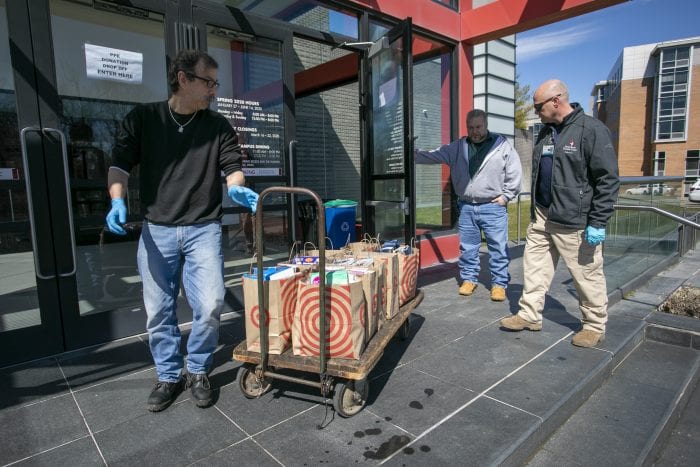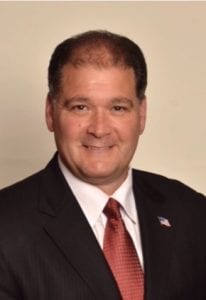Local businesses throughout Long Island have been hit hard because of the ongoing coronavirus pandemic, but it also has brought them closer together. These uncertain times have bred creative and unique ideas in an effort to keep these storefronts afloat.

For Renee Goldfarb, owner of Origin of Era boutique in Port Jefferson, it meant finding ways to further connect with clients and new customers despite them not being able to come into the store.
“There’s not the heavy foot traffic we are used to seeing, so instead of just sitting in an empty store why not continue to interact with customers online?” she said.
Goldfarb started what she calls a “virtual shopping experience” where she showcases and models different pieces of clothing from a number of indie and female designers. In these half-hour livestreams, she said it allows customers to get that familiar experience of seeing products in real time and decide what they like.
“I’m very hands on; I want them to see how these pieces look on a normal human being, not just a store mannequin,” the boutique owner said. “The viewers also leave comments and it gives me the chance to talk to them and answer their questions.”
Goldfarb currently produces weekly videos on Instagram Live and Facebook. She said she has already sold a few items from her store and is getting good feedback from customers on the videos.
“The business community in Port Jeff is really trying to support one another,” she said.
Though times have been trying, it has not stopped local shops from supporting those who arguably need it the most.
Similarly, the Port Jefferson Business Improvement District is conducting a restaurant delivery program that will send meals to St. Charles and Mather hospitals for the medical staff, to thank them for their service during the ongoing pandemic. The Greater Port Jeff Chamber of Commerce is also assisting in the effort.
Theresa Skogen, liaison for the Port Jeff BID and the chamber, said they already started to drop off meals at the hospitals earlier last week.
“We started last Saturday — it’s been a good way to revitalize some of the businesses that had to shut down and it keeps them busy during their slower days,” she said.
James Luciano, owner of the Port Jeff Lobster House and BID secretary, said the BID is donating up to 40 meals at a time to the hospitals on a rotating basis.
“Any restaurant that is in the Greater Port Jeff area can participate,” he said. “The BID will pay them a flat fee of $500 for 40 meals. We pick up the meals and deliver them to the hospitals for free.”
Luciano said they hope to continue delivering meals every day to the local hospitals.
In addition, the Port Jeff chamber has set up a GoFundMe page to raise funds to help Port Jeff restaurants feed hospital workers at St. Charles and John T. Mather hospitals. GreaterPortJeff.com is sponsoring fundraising efforts for the restaurants involved and the campaign will also help local restaurants. As of today, close to $4,000 has been raised.
“We wanted to make sure we could provide that service, and be able to employ local personnel.”
-James Luciano
In an effort to further help Port Jeff businesses, the Village of Port Jefferson has created a website page titled Open Today. The page contains a list of over 30 restaurants and other businesses. The BID is also sponsoring a free delivery service from 12 to 8 p.m. daily.
Luciano said they wanted to have a centralized delivery system in the village during this time and at the same time have this option available to customers.
“We wanted to make sure we could provide that service, and be able to employ local personnel,” he said.
For some entrepreneurs, making sure customers know that they are still present is just as important, despite seeing a dip in business.
Gabriela Schwender, of Long Island Crafty Ones, a mobile and traveling workshop based in Rocky Point, said a lot of business plans have had to be canceled due to the pandemic. Her craft workshops cater to face-to-face interactions with her clients.
In the meantime, she has been livestreaming craft workshops on the business’ Facebook page. While she can’t provide art materials like she usually does, Schwender said she has turned to finding common household objects that can make for fun craft projects.
“Usually when I do these workshops, I’m right there to help them or guide them,” she said. “Right now, I’m answering questions through text.”
Schwender said a number of viewers have already reached out to her saying that they would like to hire her once the pandemic/shutdown is over.
Gary Pollakusky, executive director of the Rocky Point Sound Beach Chamber of Commerce, said small businesses are going through a difficult time right now, adding the chamber has reached out to all its members in an effort to assist them in any way they can, including giving each other ideas and advice.
The organization has come up with its own page titled Shop Locally, Distance Socially, which can be found on its website (www.rpsbchamber.org) where it lists a number of restaurants, retail stores and other businesses that are still open and taking online orders. The chamber is also encouraging residents to order a gift card for now, to shop with once life returns to normal.
“These small businesses and mom-and-pop shops need the support of the public more than ever before,” he said.























